ELECTROMAGNETIC
METAMATERIALS
�
ELECTROMAGNETIC
METAMATERIALS:
TRANSMISSION LINE
THEORY AND
MICROWAVE
APPLICATIONS
The Engineering Approach
CHRISTOPHE CALOZ
´Ecole Polytechnique de Montr´eal
TATSUO ITOH
University of California at Los Angeles
A JOHN WILEY & SONS, INC., PUBLICATION
�
Copyright 2006 by John Wiley & Sons, Inc. All rights reserved.
Published by John Wiley & Sons, Inc., Hoboken, New Jersey.
Published simultaneously in Canada.
No part of this publication may be reproduced, stored in a retrieval system, or transmitted in any
form or by any means, electronic, mechanical, photocopying, recording, scanning, or otherwise,
except as permitted under Section 107 or 108 of the 1976 United States Copyright Act, without
either the prior written permission of the Publisher, or authorization through payment of the
appropriate per-copy fee to the Copyright Clearance Center, Inc., 222 Rosewood Drive, Danvers,
MA 01923, (978) 750-8400, fax (978) 750-4470, or on the web at www.copyright.com. Requests
to the Publisher for permission should be addressed to the Permissions Department, John Wiley &
Sons, Inc., 111 River Street, Hoboken, NJ 07030, (201) 748-6011, fax (201) 748-6008, or online at
http://www.wiley.com/go/permission.
Limit of Liability/Disclaimer of Warranty: While the publisher and author have used their best
efforts in preparing this book, they make no representations or warranties with respect to the
accuracy or completeness of the contents of this book and specifically disclaim any implied
warranties of merchantability or fitness for a particular purpose. No warranty may be created or
extended by sales representatives or written sales materials. The advice and strategies contained
herein may not be suitable for your situation. You should consult with a professional where
appropriate. Neither the publisher nor author shall be liable for any loss of profit or any other
commercial damages, including but not limited to special, incidental, consequential, or other
damages.
For general information on our other products and services or for technical support, please contact
our Customer Care Department within the United States at (800) 762-2974, outside the United
States at (317) 572-3993 or fax (317) 572-4002.
Wiley also publishes its books in a variety of electronic formats. Some content that appears in print
may not be available in electronic formats. For more information about Wiley products, visit our
web site at www.wiley.com.
Library of Congress Cataloging-in-Publication Data:
Caloz, Christophe, 1969-
Electromagnetic metamaterials : transmission line theory and microwave applications :
the engineering approach / Christophe Caloz, Tatsuo Itoh.
p.cm.
“Wiley-Interscience publication.”
Includes bibliographical references and index.
ISBN-10: 0-471-66985-7 (alk.paper)
ISBN-13: 978-0-471-66985-2 (alk.paper)
1. Magnetic materials. 2. Nanostructured materials. 3. Microwave transmission lines. I.
Itoh, Tatsuo. II. Title.
TK454.4.M3C36 2006
620.1
18—dc22
Printed in the United States of America.
10 9 8 7 6 5 4 3 2 1
2005048976
�
To Dominique, Maxime, and Rapha¨el
Christophe
�
CONTENTS
Preface
Acknowledgments
Acronyms
1 Introduction
xiii
xv
xvii
1
1.1 Definition of Metamaterials (MTMs) and Left-Handed (LH) MTMs, 1
1.2 Theoretical Speculation by Viktor Veselago, 3
1.3 Experimental Demonstration of Left-Handedness, 4
1.4 Further Numerical and Experimental Confirmations, 9
1.5 “Conventional” Backward Waves and Novelty of LH MTMs, 10
1.6 Terminology, 12
1.7 Transmission Line (TL) Approach, 12
1.8 Composite Right/Left-Handed (CRLH) MTMs, 16
1.9 MTMs and Photonic Band-Gap (PBG) Structures, 17
1.10 Historical “Germs” of MTMs, 20
References, 22
2 Fundamentals of LH MTMs
2.1 Left-Handedness from Maxwell’s Equations, 28
2.2 Entropy Conditions in Dispersive Media, 33
2.3 Boundary Conditions, 38
27
vii
�
viii
CONTENTS
2.4 Reversal of Doppler Effect, 39
2.5 Reversal of Vavilov- ˘Cerenkov Radiation, 41
2.6 Reversal of Snell’s Law: Negative Refraction, 43
2.7 Focusing by a “Flat LH Lens”, 46
2.8 Fresnel Coefficients, 48
2.9 Reversal of Goos-H¨anchen Effect, 50
2.10 Reversal of Convergence and Divergence in Convex and Concave
Lenses, 51
2.11 Subwavelength Diffraction, 53
References, 57
3 TL Theory of MTMs
59
3.1 Ideal Homogeneous CRLH TLs, 59
3.1.1 Fundamental TL Characteristics, 60
3.1.2 Equivalent MTM Constitutive Parameters, 67
3.1.3 Balanced and Unbalanced Resonances, 70
3.1.4 Lossy Case, 74
3.2 LC Network Implementation, 79
3.2.1 Principle, 79
3.2.2 Difference with Conventional Filters, 83
3.2.3 Transmission Matrix Analysis, 85
3.2.4 Input Impedance, 100
3.2.5 Cutoff Frequencies, 103
3.2.6 Analytical Dispersion Relation, 106
3.2.7 Bloch Impedance, 113
3.2.8 Effect of Finite Size in the Presence of Imperfect
Matching, 115
3.3 Real Distributed 1D CRLH Structures, 119
3.3.1 General Design Guidelines, 120
3.3.2 Microstrip Implementation, 122
3.3.3 Parameters Extraction, 124
3.4 Experimental Transmission Characteristics, 127
3.5 Conversion from Transmission Line to Constitutive Parameters, 131
References, 131
4 Two-Dimensional MTMs
4.1 Eigenvalue Problem, 134
133
4.1.1 General Matrix System, 134
4.1.2 CRLH Particularization, 138
4.1.3 Lattice Choice, Symmetry Points, Brillouin Zone, and 2D
Dispersion Representations, 139
4.2 Driven Problem by the Transmission Matrix Method (TMM), 143
4.2.1 Principle of the TMM, 144
4.2.2 Scattering Parameters, 145
�
CONTENTS
ix
4.2.3 Voltage and Current Distributions, 147
4.2.4 Interest and Limitations of the TMM, 154
4.3 Transmission Line Matrix (TLM) Modeling Method, 154
4.3.1 TLM Modeling of the Unloaded TL Host Network, 155
4.3.2 TLM Modeling of the Loaded TL Host Network (CRLH), 158
4.3.3 Relationship between Material Properties and the TLM Model
Parameters, 159
4.3.4 Suitability of the TLM Approach for MTMs, 161
4.4 Negative Refractive Index (NRI) Effects, 162
4.4.1 Negative Phase Velocity, 162
4.4.2 Negative Refraction, 163
4.4.3 Negative Focusing, 165
4.4.4 RH-LH Interface Surface Plasmons, 167
4.4.5 Reflectors with Unusual Properties, 169
4.5 Distributed 2D Structures, 170
4.5.1 Description of Possible Structures, 171
4.5.2 Dispersion and Propagation Characteristics, 173
4.5.3 Parameter Extraction, 178
4.5.4 Distributed Implementation of the NRI Slab, 183
References, 190
5 Guided-Wave Applications
5.1 Dual-Band Components, 193
192
5.1.1 Dual-Band Property of CRLH TLs, 193
5.1.2 Quarter-Wavelength TL and Stubs, 197
5.1.3 Passive Component Examples: Quadrature Hybrid and
Wilkinson Power Divider, 201
5.1.3.1 Quadrature Hybrid, 201
5.1.3.2 Wilkinson Power Divider, 202
5.1.4 Nonlinear Component Example: Quadrature Subharmonically
Pumped Mixer, 205
5.2 Enhanced-Bandwidth Components, 210
5.2.1 Principle of Bandwidth Enhancement, 211
5.2.2 Rat-Race Coupler Example, 215
5.3 Super-compact Multilayer “Vertical” TL, 217
5.3.1 “Vertical” TL Architecture, 219
5.3.2 TL Performances, 221
5.3.3 Diplexer Example, 225
5.4 Tight Edge-Coupled Coupled-Line Couplers (CLCs), 227
5.4.1 Generalities on Coupled-Line Couplers, 228
5.4.1.1 TEM and Quasi-TEM Symmetric Coupled-Line
Structures with Small Interspacing: Impedance
Coupling (IC), 228
5.4.1.2 Non-TEM Symmetric Coupled-Line Structures with
Relatively Large Spacing: Phase Coupling (PC), 232
�
x
CONTENTS
5.4.1.3 Summary on Symmetric Coupled-Line Structures, 233
5.4.1.4 Asymmetric Coupled-Line Structures, 234
5.4.1.5 Advantages of MTM Couplers, 235
5.4.2 Symmetric Impedance Coupler, 235
5.4.3 Asymmetric Phase Coupler, 245
5.5 Negative and Zeroth-Order Resonator, 249
5.5.1 Principle, 249
5.5.2 LC Network Implementation, 251
5.5.3 Zeroth-Order Resonator Characteristics, 253
5.5.4 Circuit Theory Verification, 256
5.5.5 Microstrip Realization, 258
References, 259
6 Radiated-Wave Applications
261
6.1 Fundamental Aspects of Leaky-Wave Structures, 262
6.1.1 Principle of Leakage Radiation, 262
6.1.2 Uniform and Periodic Leaky-Wave Structures, 266
6.1.2.1 Uniform LW Structures, 266
6.1.2.2 Periodic LW Structures, 268
6.1.3 Metamaterial Leaky-Wave Structures, 269
6.2 Backfire-to-Endfire (BE) Leaky-Wave (LW) Antenna, 270
6.3 Electronically Scanned BE LW Antenna, 275
6.3.1 Electronic Scanning Principle, 276
6.3.2 Electronic Beamwidth Control Principle, 277
6.3.3 Analysis of the Structure and Results, 279
6.4 Reflecto-Directive Systems, 282
6.4.1 Passive Retro-Directive Reflector, 283
6.4.2 Arbitrary-Angle Frequency Tuned Reflector, 286
6.4.3 Arbitrary-Angle Electronically Tuned Reflector, 287
6.5 Two-Dimensional Structures, 290
6.5.1 Two-Dimensional LW Radiation, 290
6.5.2 Conical-Beam Antenna, 292
6.5.3 Full-Space Scanning Antenna, 296
6.6 Zeroth Order Resonating Antenna, 297
6.7 Dual-Band CRLH-TL Resonating Ring Antenna, 300
6.8 Focusing Radiative “Meta-Interfaces”, 304
6.8.1 Heterodyne Phased Array, 305
6.8.2 Nonuniform Leaky-Wave Radiator, 310
References, 313
7 The Future of MTMs
316
7.1 “Real-Artificial” Materials: the Challenge of Homogenization, 316
7.2 Quasi-Optical NRI Lenses and Devices, 319
7.3 Three-Dimensional Isotropic LH MTMs, 323
�
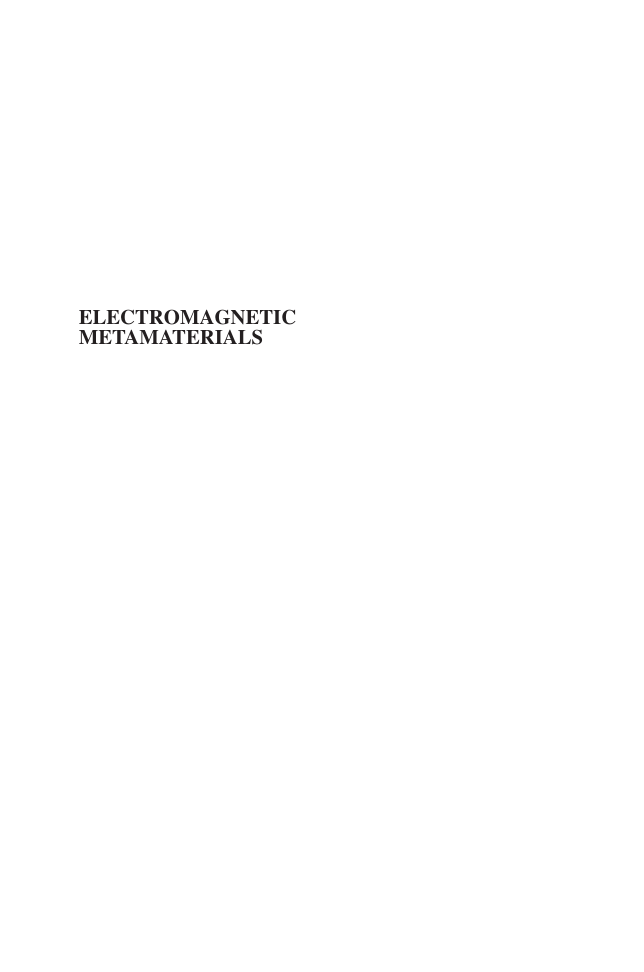
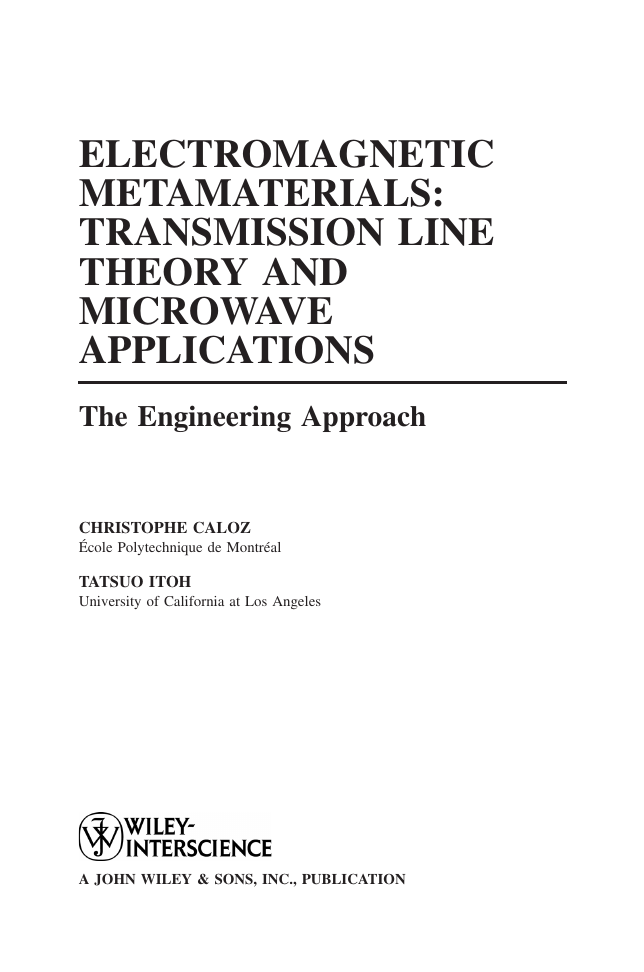
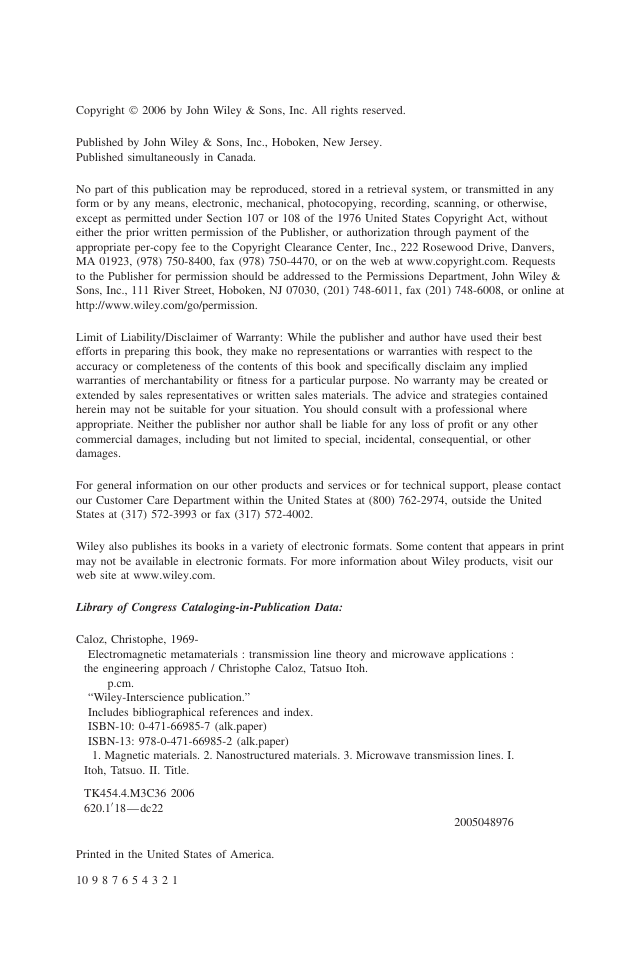

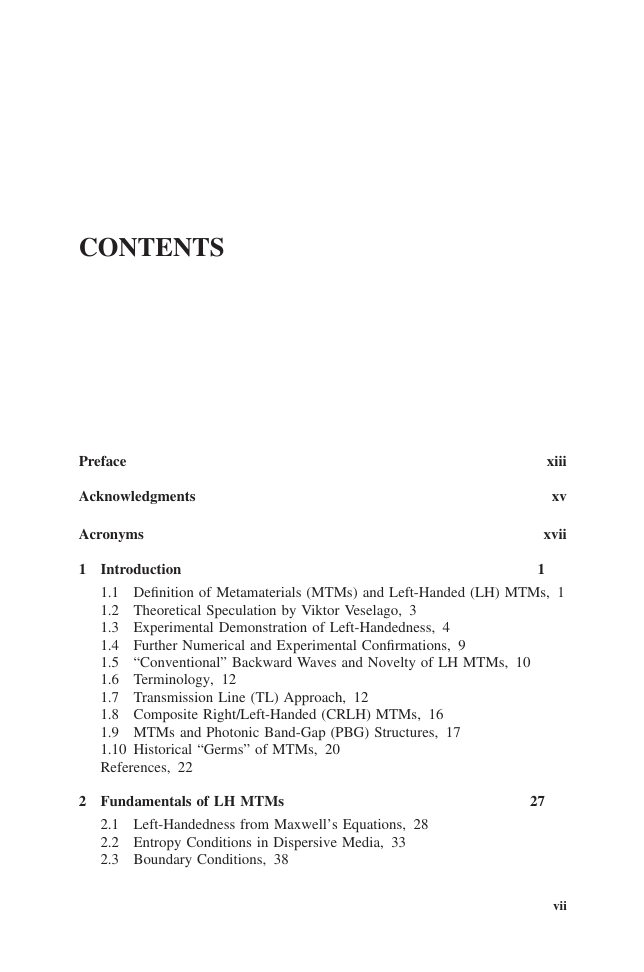
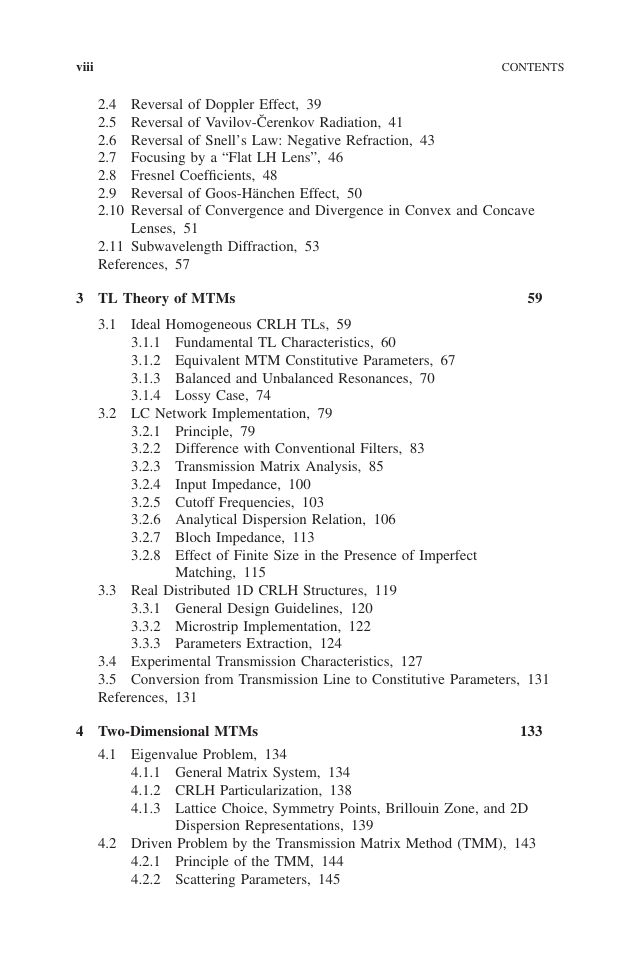
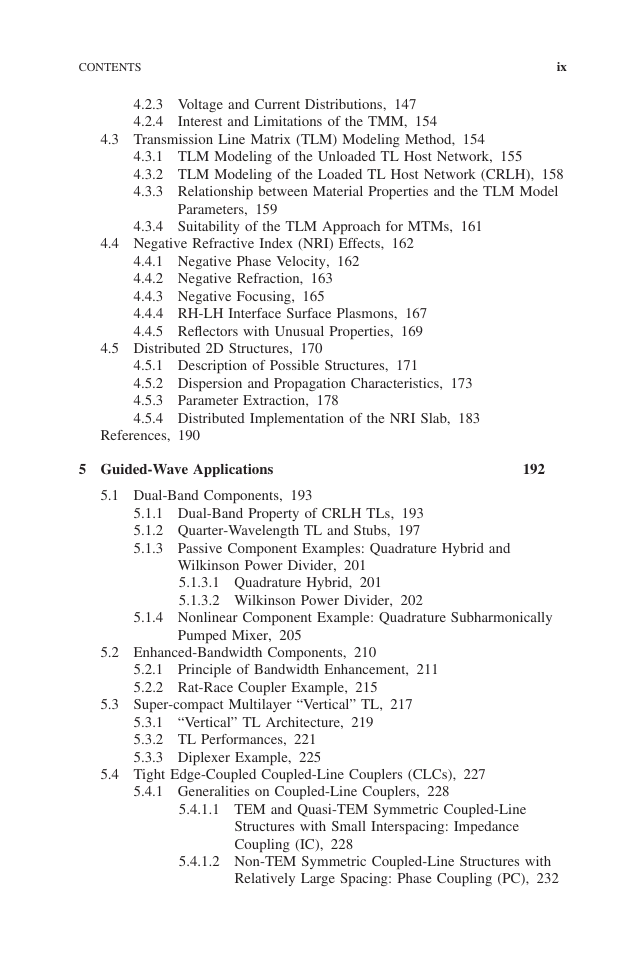
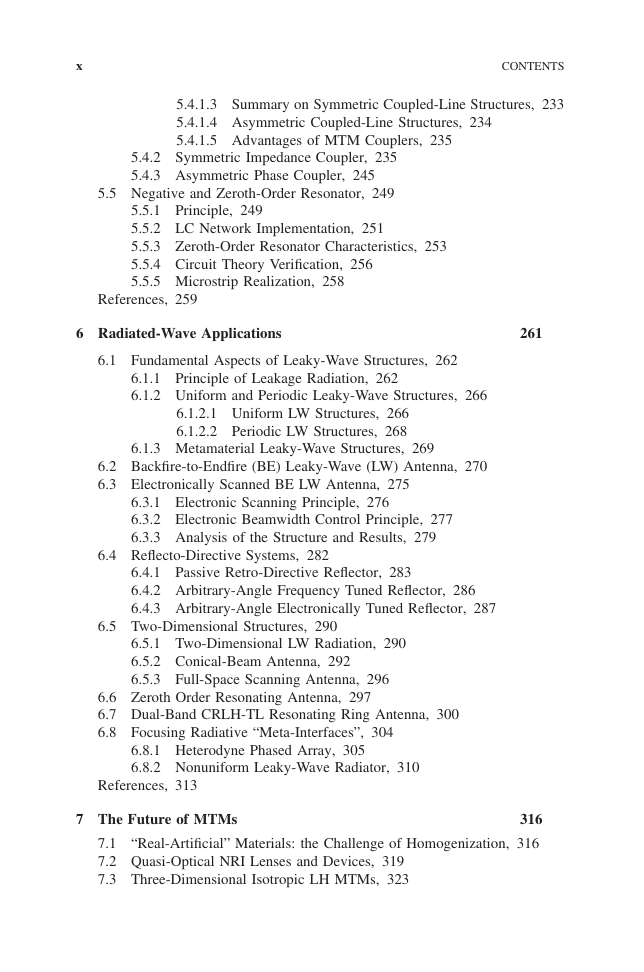








 2023年江西萍乡中考道德与法治真题及答案.doc
2023年江西萍乡中考道德与法治真题及答案.doc 2012年重庆南川中考生物真题及答案.doc
2012年重庆南川中考生物真题及答案.doc 2013年江西师范大学地理学综合及文艺理论基础考研真题.doc
2013年江西师范大学地理学综合及文艺理论基础考研真题.doc 2020年四川甘孜小升初语文真题及答案I卷.doc
2020年四川甘孜小升初语文真题及答案I卷.doc 2020年注册岩土工程师专业基础考试真题及答案.doc
2020年注册岩土工程师专业基础考试真题及答案.doc 2023-2024学年福建省厦门市九年级上学期数学月考试题及答案.doc
2023-2024学年福建省厦门市九年级上学期数学月考试题及答案.doc 2021-2022学年辽宁省沈阳市大东区九年级上学期语文期末试题及答案.doc
2021-2022学年辽宁省沈阳市大东区九年级上学期语文期末试题及答案.doc 2022-2023学年北京东城区初三第一学期物理期末试卷及答案.doc
2022-2023学年北京东城区初三第一学期物理期末试卷及答案.doc 2018上半年江西教师资格初中地理学科知识与教学能力真题及答案.doc
2018上半年江西教师资格初中地理学科知识与教学能力真题及答案.doc 2012年河北国家公务员申论考试真题及答案-省级.doc
2012年河北国家公务员申论考试真题及答案-省级.doc 2020-2021学年江苏省扬州市江都区邵樊片九年级上学期数学第一次质量检测试题及答案.doc
2020-2021学年江苏省扬州市江都区邵樊片九年级上学期数学第一次质量检测试题及答案.doc 2022下半年黑龙江教师资格证中学综合素质真题及答案.doc
2022下半年黑龙江教师资格证中学综合素质真题及答案.doc